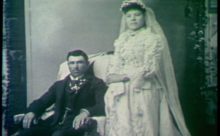Teacher's Guide, CELEBRACIÓN DEL MATRIMONIO
CELEBRACIÓN DEL MATRIMONIO
Teacher’s Guide for Secondary Schools
Prepared when the film was first released in 1986 to accompany copies circulated by the University of California Extension Media Center.
Audience Level: Secondary, College, General Adult
Subject uses: Ethnography/Multicultural; Hispanic/Chicano Studies; American History/Culture;
Family Life/Sociology; Folklore; Home Economics; Women’s Studies; Religion;
Advanced Spanish (Spanish-language version); Bilingual Education; General Interest
Summary
This sensitive portrait of a traditional Hispanic wedding ceremony in northern New Mexico illuminates the rich heritage of Hispanic culture in the Southwest and illustrates the continuing importance of traditional customs and values in contemporary American life. The film begins with an historical overview of Hispanic marriage customs, noting how they mirror customs in Spain, Mexico, and North Africa that were brought to the Southwest by the region’s first European colonists in 1598. Then, in the village of El Rito, the film follows the entire nuptial sequence—from betrothal through the grand celebration—and shows how it incorporates forms of cultural, artistic, and religious expression unique to the region.
Before Viewing
1. Culture might be defined as all the things that give life meaning for a particular group of people, and this meaning may be exhibited in both everyday and ceremonial activities. Ask students to keep this simple definition in mind as they watch the film, and to consider how the Hispanic culture of the Southwest is similar to and different from their own.
2. Traditions give cultures continuity and durability. Ask students to consider, as they watch the film, the importance of traditions to Cecilia and William, the newlyweds, and to reflect upon the nature and importance of their own cultural traditions.
3. Ask students to watch for how the singing of the entriega and the baile “welcome” the newlyweds into the community, and how the roles and relationships of the man and the woman are emphasized through the rituals. Ask students to consider the symbolic function of a wedding ceremony and of other kinds of ceremonies with which they are familiar.
Discussion Questions after Viewing
1. What reasons can you imagine for having a traditional wedding? Might this kind of wedding strengthen ties between families and within a community? Might it strengthen the marriage itself?
2. Cecilia and William considered their wedding to be ideal, and to be connected to their concept of marriage. What do you believe makes a wedding ideal? What should a wedding symbolize? What is the importance of religion to a wedding, a marriage, and a culture?
3. Which aspects of Hispanic culture in the Southwest seemed most striking to you? Which had you never known about before? Which seem most similar to and which seem most different from your own culture?
Suggested Activities
1. A family history project. Collect family wedding photos and records and write a short description of an important wedding in your own family. You may want to interview your family members. How did the engagement take place? What kinds of preparations were made for the wedding? What do people most remember about the wedding?
2. Compare and contrast two or more weddings that you have attended. This can be especially interesting if ethnic traditions are involved. What differences do you find in ritual, music, dress, and food and drink?
For Further Reading
Craver, Rebecca M. The Impact of Intimacy: Mexican-Anglo Intermarriage in New Mexico,
1821-1846. [El Paso:] Texas Western Press, University of Texas at El Paso, 1982.
[Gilbert], Fabiola Cabeza de Baca. We Fed Them Cactus. 2nd ed. Albuquerque: University of
New Mexico Press, 1994.
Jamarillo, Cleofas M. Shadows of the Past. Santa Fe: Seton Village Press, 1941.
Swadesh, Frances Leon. Los Primeros Pobladores. Notre Dame: University of Notre Dame
Press, 1974. [This is in English.]
Papers in the New Mexico WPA Writers’ Files:
#325: Hinojos, Rosario O., “Old Time Wedding Customs”
#333: Lucero-White, Aurora, “Casorios”
#457: Martínez, Reyes N., “Rural Weddings”
